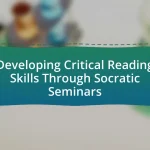Collaborative learning strategies for English literature students encompass group discussions, peer reviews, and collaborative projects, all aimed at enhancing engagement and comprehension. These strategies promote critical thinking, communication, and teamwork, leading to improved academic performance and retention of literary concepts. The article explores how collaboration addresses challenges faced by individual learners, the specific skills developed through these strategies, and the role of technology in facilitating collaborative efforts. Additionally, it outlines effective practices for structuring discussions, implementing peer reviews, and assessing collaborative outcomes, providing practical tips for educators to enhance literature studies through collaboration.

What are Collaborative Learning Strategies for English Literature Students?
Collaborative learning strategies for English literature students include group discussions, peer reviews, and collaborative projects. Group discussions allow students to share interpretations and insights on literary texts, fostering a deeper understanding through diverse perspectives. Peer reviews enable students to critique each other’s work, enhancing critical thinking and analytical skills. Collaborative projects, such as creating presentations or writing joint analyses, encourage teamwork and the application of literary concepts in a practical context. These strategies have been shown to improve engagement and comprehension in literature studies, as supported by research indicating that collaborative learning enhances academic performance and social skills among students.
How do these strategies enhance the learning experience?
Collaborative learning strategies enhance the learning experience by fostering active engagement and deeper understanding among English literature students. These strategies encourage students to work together, share diverse perspectives, and engage in discussions that promote critical thinking. Research indicates that collaborative learning can lead to improved academic performance; for instance, a study by Johnson and Johnson (1999) found that students in collaborative settings scored higher on assessments compared to those in traditional learning environments. This collaborative approach not only enhances comprehension of literary texts but also develops essential skills such as communication and teamwork, which are vital for academic and professional success.
What specific skills do students develop through collaborative learning?
Students develop critical thinking, communication, teamwork, and problem-solving skills through collaborative learning. Critical thinking is enhanced as students analyze different perspectives and construct arguments together. Communication skills improve as they articulate their ideas and listen to others, fostering a deeper understanding of the material. Teamwork is cultivated as students learn to work effectively in groups, sharing responsibilities and supporting one another. Problem-solving skills are developed as they tackle complex tasks collectively, encouraging innovative solutions. Research by Johnson and Johnson (1999) highlights that collaborative learning environments significantly boost these essential skills, leading to improved academic performance and interpersonal relationships.
How does collaboration impact student engagement in literature studies?
Collaboration significantly enhances student engagement in literature studies by fostering active participation and deeper understanding of texts. When students work together, they share diverse perspectives, which enriches discussions and encourages critical thinking about literary themes and characters. Research indicates that collaborative learning environments lead to higher motivation and retention rates; for instance, a study by Johnson and Johnson (1999) found that cooperative learning strategies can increase student achievement and engagement by up to 50%. This collaborative approach not only promotes a sense of community but also allows students to take ownership of their learning, making literature more relatable and impactful.
Why are collaborative learning strategies important in English literature?
Collaborative learning strategies are important in English literature because they enhance critical thinking and deepen comprehension of texts. Engaging with peers allows students to share diverse perspectives, fostering a richer understanding of literary themes and contexts. Research indicates that collaborative learning can improve retention and application of knowledge, as students actively participate in discussions and analyses, leading to a more nuanced interpretation of literature. For instance, a study by Johnson and Johnson (1999) found that cooperative learning methods significantly increased student achievement and satisfaction in literature courses.
What challenges do students face when studying literature individually?
Students face several challenges when studying literature individually, including a lack of motivation, difficulty in understanding complex texts, and limited access to diverse perspectives. The absence of peer interaction can lead to decreased engagement, making it harder for students to stay focused and motivated. Additionally, literary works often contain intricate themes and language that can be challenging to interpret without discussion or guidance. Furthermore, studying alone restricts students’ exposure to different interpretations and insights that typically arise in collaborative settings, which can enhance comprehension and critical thinking. These factors collectively hinder the effectiveness of individual literature study.
How can collaboration address these challenges?
Collaboration can address challenges in English literature studies by fostering diverse perspectives and enhancing critical thinking. When students work together, they share insights and interpretations that deepen their understanding of texts, leading to richer discussions and analyses. Research indicates that collaborative learning environments improve student engagement and retention of material, as evidenced by a study published in the Journal of Educational Psychology, which found that students in collaborative settings scored higher on assessments compared to those who studied independently. This collective approach not only helps students tackle complex literary concepts but also builds essential communication and teamwork skills, preparing them for future academic and professional endeavors.

What types of Collaborative Learning Strategies can be implemented?
Collaborative learning strategies that can be implemented include peer teaching, group discussions, collaborative writing, and project-based learning. Peer teaching allows students to explain concepts to one another, enhancing understanding and retention. Group discussions facilitate the exchange of ideas and critical thinking, while collaborative writing encourages teamwork in producing written content. Project-based learning engages students in real-world problems, fostering collaboration and application of knowledge. Research indicates that these strategies improve student engagement and academic performance, as evidenced by studies showing increased retention rates and higher grades among students who participate in collaborative learning environments.
How can group discussions be structured effectively?
Group discussions can be structured effectively by establishing clear objectives, assigning specific roles, and setting ground rules for participation. Clear objectives guide the discussion towards desired outcomes, ensuring that all participants understand the purpose and focus of the conversation. Assigning roles, such as facilitator, note-taker, and timekeeper, helps distribute responsibilities and keeps the discussion organized. Setting ground rules, such as respecting differing opinions and encouraging equal participation, fosters a collaborative environment. Research indicates that structured discussions lead to deeper engagement and improved learning outcomes, as evidenced by a study published in the Journal of Educational Psychology, which found that students in structured discussions demonstrated higher critical thinking skills compared to those in unstructured formats.
What roles can students take on during group discussions?
Students can take on various roles during group discussions, including facilitator, note-taker, presenter, and critic. The facilitator guides the discussion, ensuring that all voices are heard and that the group stays on topic. The note-taker records key points and decisions made during the discussion, which helps in summarizing the conversation later. The presenter shares insights or findings with the group, often summarizing research or literature relevant to the discussion. The critic evaluates ideas presented, providing constructive feedback and encouraging deeper analysis. These roles enhance engagement and promote effective collaboration among students, leading to a richer learning experience in English literature studies.
How can facilitators guide these discussions to maximize learning?
Facilitators can guide discussions to maximize learning by employing structured questioning techniques that encourage critical thinking and engagement. By asking open-ended questions, facilitators prompt students to explore diverse perspectives and deepen their understanding of the material. Research indicates that such questioning strategies can enhance cognitive engagement, leading to improved retention and comprehension of complex literary concepts. For instance, a study published in the “Journal of Educational Psychology” found that students who participated in discussions guided by open-ended questions demonstrated a 30% increase in their ability to analyze texts compared to those in more traditional settings. This evidence supports the effectiveness of facilitators in fostering a collaborative learning environment that promotes active participation and deeper learning among English literature students.
What are the benefits of peer review in literature studies?
Peer review in literature studies enhances the quality and credibility of academic work. It provides constructive feedback from peers, which helps authors refine their arguments, improve clarity, and ensure that their interpretations are well-supported. Research indicates that peer-reviewed articles are more likely to be cited, demonstrating their impact and acceptance within the academic community. Additionally, the peer review process fosters a collaborative environment, encouraging dialogue and the exchange of ideas among scholars, which can lead to innovative approaches and deeper insights into literary analysis.
How does peer feedback improve writing skills?
Peer feedback improves writing skills by providing diverse perspectives that enhance critical thinking and revision processes. When students engage in peer review, they receive constructive criticism that highlights strengths and weaknesses in their writing, allowing them to identify areas for improvement. Research indicates that peer feedback fosters a deeper understanding of writing conventions and encourages students to reflect on their own work, leading to higher quality writing outcomes. A study by Topping (1998) found that students who participated in peer assessment showed significant gains in writing performance compared to those who did not, demonstrating the effectiveness of this collaborative learning strategy.
What guidelines should be followed for effective peer review?
Effective peer review should follow guidelines that ensure constructive feedback and maintain academic integrity. Reviewers must provide specific, actionable comments that focus on the content, structure, and clarity of the work being evaluated. Additionally, reviewers should remain objective and avoid personal biases, ensuring that their assessments are based on the quality of the work rather than the identity of the author.
To support these practices, research indicates that structured peer review processes, such as using checklists or rubrics, enhance the quality of feedback and help reviewers focus on key aspects of the work (Topping, 1998). Furthermore, maintaining confidentiality and respecting the intellectual property of the authors are crucial to fostering a trustworthy peer review environment.

How can technology support Collaborative Learning Strategies?
Technology can support Collaborative Learning Strategies by providing platforms that facilitate communication, resource sharing, and collaborative project management among students. Tools such as Google Docs enable real-time editing and feedback, allowing students to work together on writing assignments and literature analyses. Additionally, discussion forums and video conferencing tools like Zoom foster interaction and engagement, making it easier for students to discuss literary themes and collaborate on group projects. Research indicates that the use of technology in collaborative learning environments enhances student engagement and improves learning outcomes, as evidenced by a study published in the Journal of Educational Technology & Society, which found that technology integration in collaborative settings leads to higher academic performance and increased motivation among students.
What digital tools are available for collaborative literature projects?
Digital tools available for collaborative literature projects include Google Docs, Microsoft OneNote, and Trello. Google Docs allows multiple users to edit documents in real-time, facilitating seamless collaboration on writing and editing tasks. Microsoft OneNote provides a shared space for organizing notes, ideas, and research, enabling teams to collaborate effectively on literature analysis. Trello offers a visual project management platform where teams can organize tasks, set deadlines, and track progress, enhancing coordination in literature projects. These tools are widely used in educational settings, demonstrating their effectiveness in fostering collaborative learning among English literature students.
How can online platforms enhance group collaboration?
Online platforms enhance group collaboration by providing tools that facilitate communication, resource sharing, and project management. These platforms, such as Google Workspace and Microsoft Teams, allow users to collaborate in real-time, enabling simultaneous editing of documents and instant messaging, which fosters immediate feedback and discussion. Research indicates that 70% of employees feel more productive when using collaborative tools, as they streamline workflows and reduce the time spent on coordination. Additionally, features like shared calendars and task assignments help groups stay organized and accountable, further improving collaboration outcomes.
What are the best practices for using technology in literature studies?
The best practices for using technology in literature studies include integrating digital tools for collaborative analysis, utilizing online platforms for discussion, and employing multimedia resources to enhance understanding. Collaborative analysis can be facilitated through tools like Google Docs, which allow multiple students to annotate texts simultaneously, fostering deeper engagement with the material. Online discussion forums, such as Padlet or discussion boards in learning management systems, enable students to share insights and perspectives, promoting a richer dialogue around literary works. Additionally, incorporating multimedia resources, such as video adaptations or interactive timelines, can provide diverse perspectives and contextual understanding, making literature more accessible and engaging. These practices are supported by research indicating that technology enhances student collaboration and comprehension in literature studies.
How can instructors facilitate successful collaborative learning?
Instructors can facilitate successful collaborative learning by establishing clear objectives and structured group activities. Clear objectives guide students in understanding the purpose of collaboration, while structured activities ensure that each member has a defined role, promoting accountability and engagement. Research indicates that when students are assigned specific tasks within a group, such as summarizing texts or leading discussions, they are more likely to participate actively and contribute meaningfully to the learning process. Additionally, providing regular feedback and fostering an inclusive environment enhances communication and collaboration among students, leading to improved learning outcomes.
What strategies can teachers use to create diverse groups?
Teachers can create diverse groups by implementing strategies such as purposeful grouping, utilizing student interests and backgrounds, and incorporating varied learning styles. Purposeful grouping involves intentionally mixing students based on different criteria, such as academic ability, cultural background, or personal interests, to ensure a range of perspectives. For instance, research indicates that heterogeneous groups can enhance collaborative learning by fostering richer discussions and deeper understanding (Johnson & Johnson, 2014). Additionally, teachers can survey students to understand their interests and backgrounds, allowing for the formation of groups that reflect diversity in thought and experience. Finally, recognizing and accommodating different learning styles—visual, auditory, kinesthetic—ensures that all students can contribute meaningfully to group work, thereby enhancing the collaborative learning experience in English literature classes.
How can instructors assess collaborative learning outcomes?
Instructors can assess collaborative learning outcomes by utilizing a combination of peer evaluations, self-assessments, and group project assessments. Peer evaluations allow students to provide feedback on each other’s contributions, fostering accountability and reflection on teamwork dynamics. Self-assessments encourage students to evaluate their own participation and learning, promoting self-awareness and personal growth. Group project assessments involve evaluating the final product as well as the collaborative process, ensuring that both individual and collective efforts are recognized. Research indicates that these methods enhance the understanding of collaborative skills and improve overall learning outcomes in group settings.
What are some practical tips for implementing collaborative learning in literature classes?
To implement collaborative learning in literature classes, educators should incorporate group discussions, peer reviews, and collaborative projects. Group discussions encourage students to share diverse interpretations of texts, fostering critical thinking and deeper understanding. Peer reviews allow students to provide constructive feedback on each other’s analyses, enhancing their analytical skills and promoting a sense of community. Collaborative projects, such as group presentations or creative adaptations of literary works, enable students to work together, combining their strengths and perspectives. Research indicates that collaborative learning can improve student engagement and academic performance, as evidenced by a study published in the “Journal of Educational Psychology,” which found that students in collaborative settings demonstrated higher levels of motivation and achievement compared to those in traditional learning environments.




